#egyptian style jewelry
Text
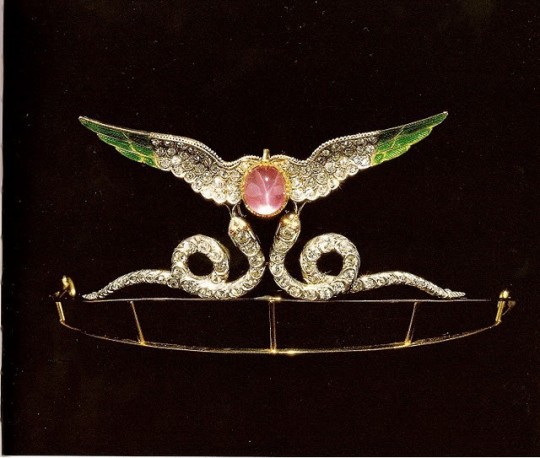
Antique Tiara Made To Resemble The Ancient Egyptian Amuletic Winged Globe; Carlo and Arthur Guilliano, Circa 1900
Gold, Green Enamel, Diamonds, Star Ruby
Source: Pinterest
#antique tiara#high jewelry tiara#egyptian style jewelry#egypt#egyptian revival#star ruby#star ruby tiara#star ruby jewelry#enamel#gold#diamonds#antique high jewelry#luxury jewelry#fine jewelry#fine jewellery pieces#gemville
531 notes
·
View notes
Photo
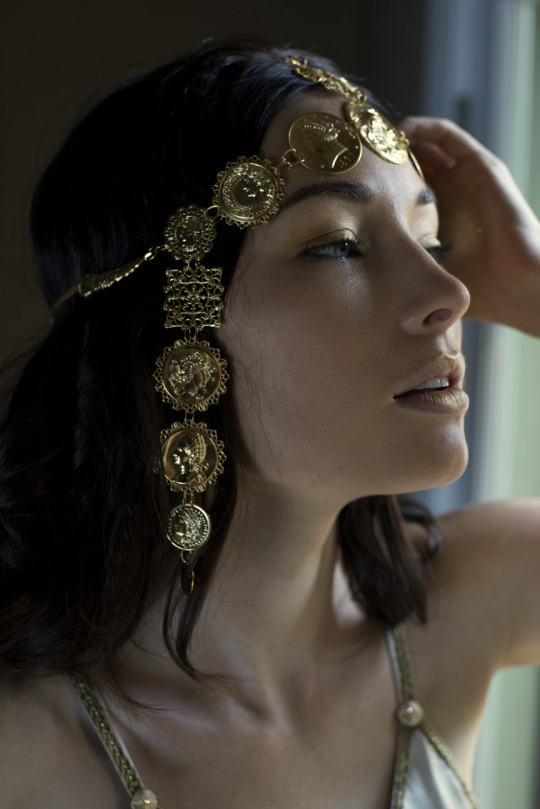
Erica Elizabeth Designs, Bijoux de Tete Collection
#woman#women#bijou#jewelry#headwear#golden#gold#Egyptian Revival#oriental#style#fashion#model#gold coin#photography
101 notes
·
View notes
Text

SALE 15% off and Free USA Shipping
Mother's Love with Unique gifting
Meaningful jewelry collection by @artsystudiofinds
#shopnow#artsystudiofinds#moldavite#silver#meteorite#green#czech#handcarved#eye of horus#spiritual growth#protection#mothers day sale#discountshopping#handmade gifts#handmade jewelry#artisan jewelry#vintage style#egyptian mythology#ancient wisdom#shopsmall#usa#freeshipping#shopping deals#musthave#buyonline#support small business#etsysmallbusiness#etsysale#etsystore#gifts for mom
0 notes
Text
Vintage King Tut Pendant Necklace circa 1970s. Click link to purchase and learn more! :)
#King Tut#jeezum crow vintage#vintage#style#etsy sellers of tumblr#etsy#vintage jewelry#egyptian#egypt#egyptian revival#Sun ra#god#deity#ancient Egypt#mma#Museum Modern Art#moma#history#gold#gold tone jewelry#gold plated brass#gold plated pewter#statement necklace#pendant necklace vintage#vtg pendant necklace#pendant necklace#chain and pendant#70s vintage#70s aesthetic#Art Deco revival
0 notes
Text
Details and analysis of 3H outfits

There is a reflection of the house color in the uniforms of students. Although the examples presented in the image are non-recruitable characters, when you recruit students, the color of the reflection in their uniforms will change to the color of your chosen house.

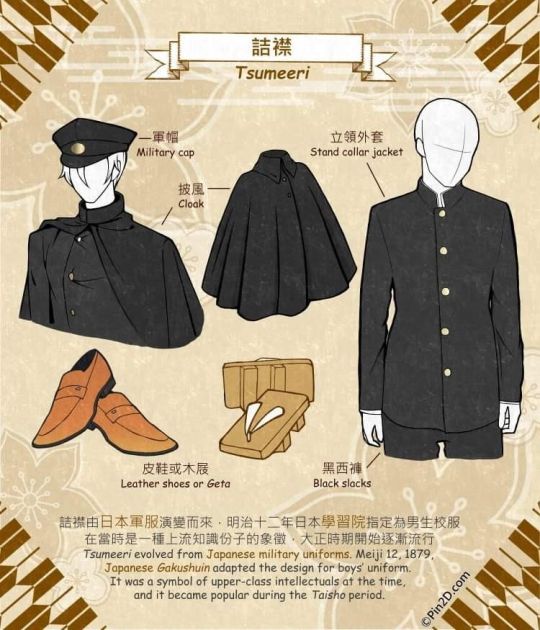
The Byleth academy uniform concept is based on the concept of student uniforms in modern japanese media. Such as the female uniform, which is based on a japanese female student uniform in terms of a hairband, short skirt, andwhite stockings. The male uniform is based on a uniform from the Taisho period.
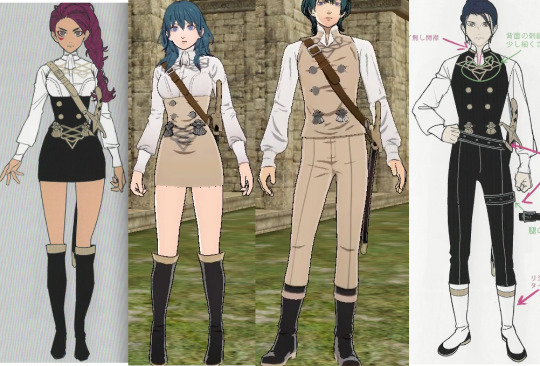
Female summer clothing is based on the Patra's uniform with the color scheme reversed, the reason may be due to Petra's nature that adapts to hot weather. However, male summer clothing is based on Felix's uniform🤔

The evening wear consists of an Aiguillette which symbolizes honour, and a stylized design of Pellegrina which has a rhombus (males) and heart (females) shape on its edges, with a standard CoS pattern on the males sleeves and females skirts. The female skirts specifically are the same design as the nun's which both contain the pattern of Sothis' dress. Since the evening wear is intended to celebrate Garreg Mach's establishment, it is only natural that the design combines a formal uniform with CoS clothing.
Duscur
The children wear clothing similar to ancient Egyptian clothing, but the clothing of the man and woman closely resembles those of northern europe. (However, I may be wrong, so feel free to add to this post if you know more about the type of clothing of the Duscur people)
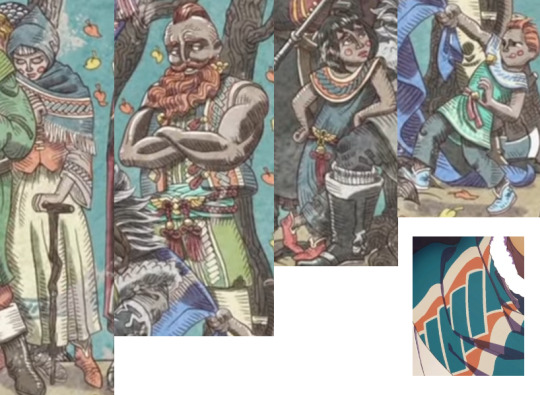
All clothing of the Duscur people of this feature a pixelated pattern, and color schemes of teal, light orange, vanilla, and red cords.
The design of their jewelry appears to be a mixture of wing symbols from cultures such as American Indians, Egyptians, and Persians.
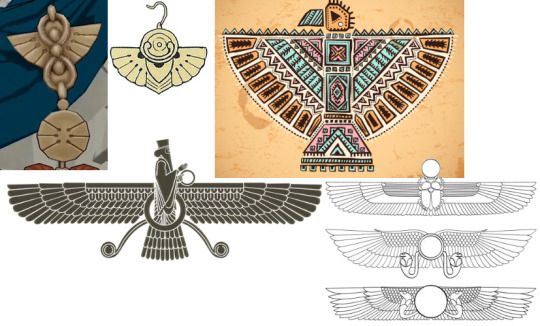
Almyra
This man from the VW end mural wears clothing similar to Nader's, and with a color scheme similar to Claude's and the color purple, which symbolizes royalty in persian culture, he is very likely the king of Almyra.
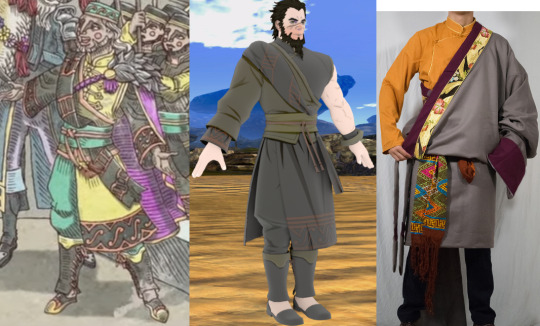
What I found interesting is that although Almyra is inspired by Persian culture, Nader and king's clothing is similar to Tibetan clothing. However, this is not a problem, there is no shame in drawing inspiration from a number of different cultures to make a culture in a fantasy story, as is the case with Duscur.
Dagda
From the clothing of the man on the camel and the helmets of the soldiers, Dagda appears to be inspired by Ottoman culture.

The reason I believe they are from Dagda is because there are many Shamir's design elements at their design.
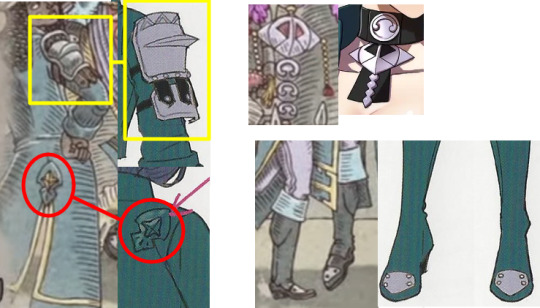
Well, my statement that "there is no shame in drawing inspiration from a number of different cultures to make a culture in a fantasy story," this is an example of the opposite.
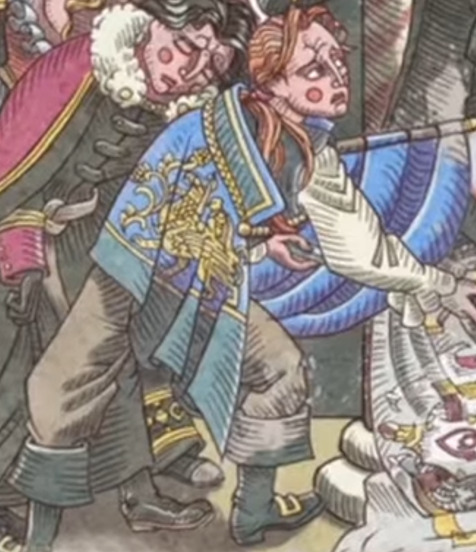
This man from the CF end mural wears the emblem of the kingdom, but his clothing style is that of the alliance. Why🤔
To know the difference between the clothing style of Fodlan countries, read this.
535 notes
·
View notes
Text

Golden Ram's-head Amulet
This amulet was probably made for a necklace worn by one of the Kushite kings. Representations show these pharaohs wearing a ram's-head amulet tied around the neck on a thick cord, the ends of which fall forward over the shoulders. Sometimes a smaller ram's head is attached to each end. Rams were associated with the god Amun, particularly in Nubia, where he was especially revered.
During the 25th Dynasty of ancient Egypt, also known as the Kushite Dynasty, ram pendants continued to be popular symbols of power, protection, and divine connection. The Kushite rulers, who were of Nubian descent, incorporated elements of both Egyptian and Nubian culture into their jewelry and artifacts. Ram pendants during this period may have featured a blend of Egyptian and Nubian artistic styles, reflecting the cultural fusion of the time. These pendants likely held similar symbolic meanings as in earlier periods, representing strength, fertility, and the divine authority of the rulers.
Third Intermediate Period, 25th Dynasty, ca. 712-664 BC.
Possibly from Nubia.
Now in the Metropolitan Museum of Art. 1989.281.98
Read more
46 notes
·
View notes
Text
Ṣafa; Egyptian Women with coins in their hair

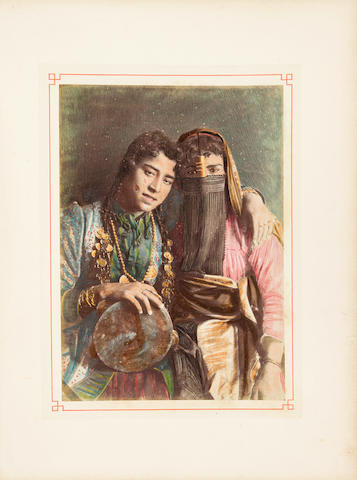



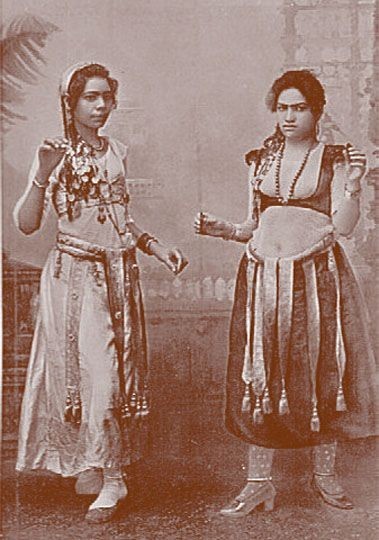
This style is attested in Edward William Lane's work from the 1830s. He describes it as follows:
The hair, except over the forehead and temples, is divided into numerous braids or plaits, generally from eleven to twenty-five in number, but always of an uneven number: these hang down the back. To each braid of hair are usually added three black silk cords, with little omaments of gold, &c., attached to them. For a description of these, which are called "ṣafa," I refer to the Appendix. Over the forehead, the hair is cut rather short; but two full locks (called "maḳàṣees"; singular "maḳṣooṣ") hang down on each side of the face: these are often curled in ringlets and sometimes plaited. (Egyptian women swear by the side-lock (as men do by the beard), generally holding it when they utter the oath, "Wa-ḥayát maḳṣooṣee!") [Page 45-46]
Further detail comes from an appendix focusing on jewelry:

It has been mentioned that all the hair of the head, except a little over the forehead and temples, is arranged in plaits, or braids, which hang down the back. These plaits are generally from eleven to twenty-five in number; but always of an uneven number: eleven is considered a scanty number: thirteen and fifteen are more common. Three times the number of black silk strings (three to each plait of hair, and each three united at the top), from sixteen to eighteen inches in length, are braided with the hair for about a quarter of their length; or they are attached to a lace or band of black silk which is bound round the head, and in this case hang entirely separate from the plaits of hair, which they almost conceal. These strings are called "ḳeyṭáns" and together with certain ornaments of gold, &c., the more common of which are here represented, compose what is tenned the "ṣafa". Along each string, except from the upper extremity to about a quarter or (at most) a third of its length are generally attached nine or more of the little flat ornaments of gold called "barḳ." These are commonly all of the same form, and about an inch, or a little more, apart; but those of each string are purposely placed so as not exactly to correspond with those of the others. The most usual forms of barḳ are Nos. 1 and 2 of the specimens given above. At the end of each string is a small gold tube, called "másoorah," about: three-eighths of an inch long, or a kind of gold bead in the form of a cube with a portion cut off from each angle, called "ḥabbeh." Beneath the másoorah or ḥabbeh is a little ring, to which is most commonly suspended a Turkish gold coin called "Ruba Fenduḳlee," equivalent to nearly 1s. 8d. of our money, and a little more than half an inch in diameter. Such is the most general description of ṣafa ; but there are more genteel kinds, in which the ḥabbeh is usually preferred to the másoorah, and instead of the Ruba Fenduḳlee is a flat ornament of gold, called, from its form, "kummetrè," or "pear." There are also other and more approved substitutes for the gold coin; the most usual of which is called "shiftisheh," composed of open gold work, with a pearl in the centre. Some ladies substitute a little tassel of pearls for the gold coin; or suspend alternately pearls and emeralds to the bottom of the triple strings; and attach a pearl with each of the barḳ. The ṣafa thus composed with pearls is called "ṣafa loolee.'' Coral beads are also sometimes attached in the same manner as the pearls. From what has been said above, it appears that a moderate ṣafa of thirteen plaits will consist of 39 strings, 351 barḳ, 39 másoorahs or ḥabbehs, and 39 gold coins or other ornaments; and that a ṣafa of twenty-five plaits, with twelve barḳ to each string, will contain no fewer than 900 barḳ, and seventy-five of each of the other appendages. The ṣafa appears to me the prettiest, as well as the most singular, of all the ornaments worn by the ladies of Egypt. The glittering of the barḳ, &c., and their chinking together as the wearer walks, have a peculiarly lively effect. [Page 572-574]
He goes onto describe a similar style worn by poorer women, but I probably will do its own post because it was still being worn in the Western Oases near the 1970s, and really doesn't use coins or barḳ.
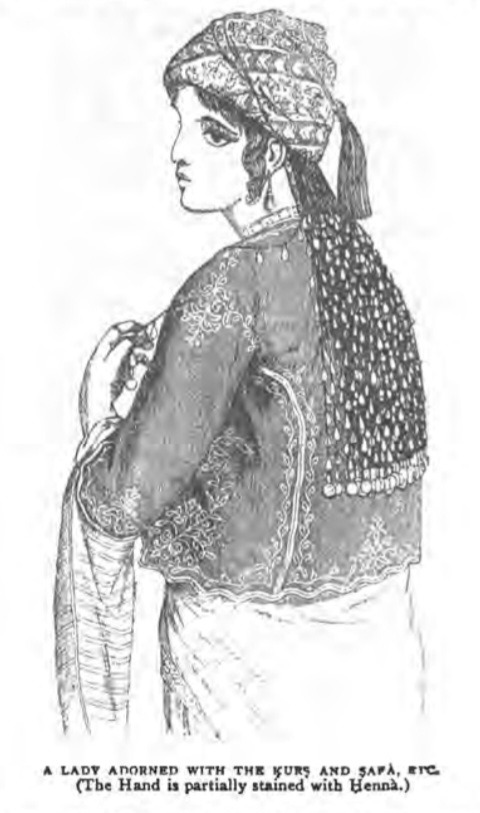

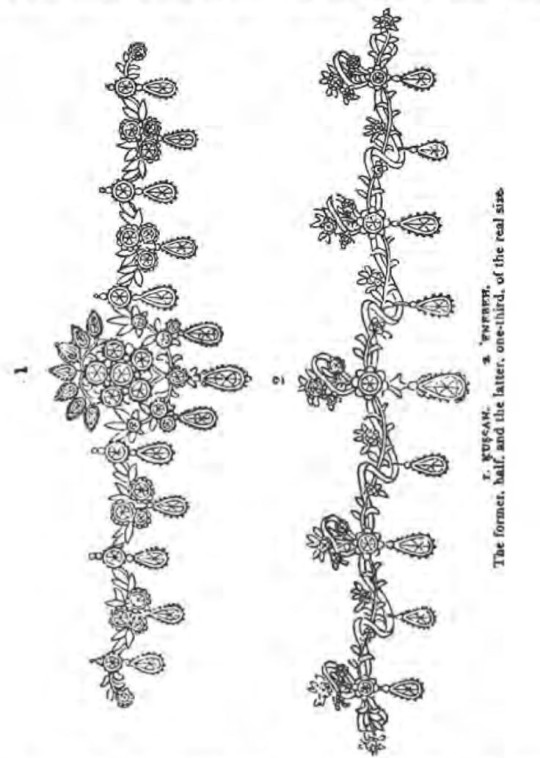
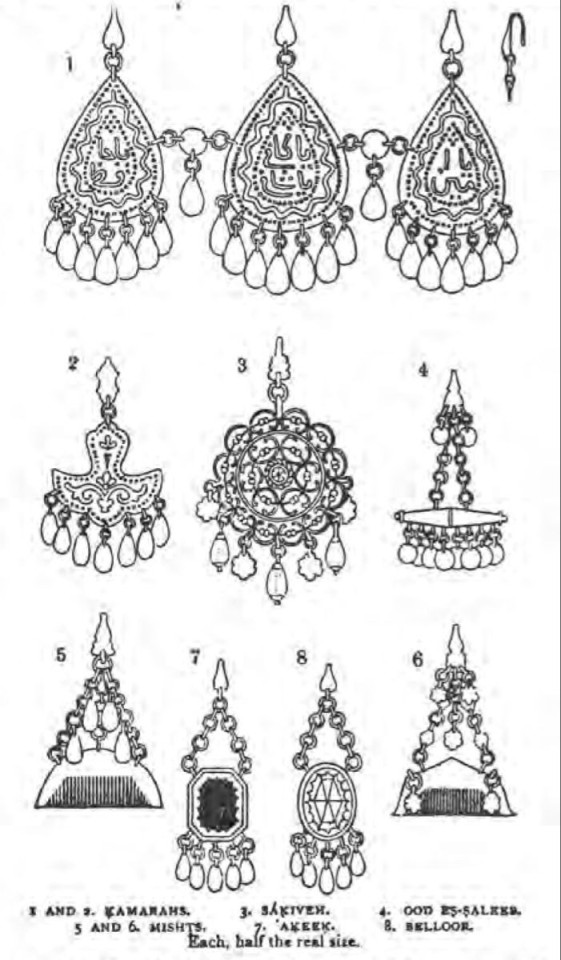
This hairstyle initally was also worn with a particular headdress of upper and middle class Egyptian women, called a rabṭah, which is essentially a woman's turban. It is made with a tarboosh or ṭáḳeeyeh (I think Lane might mean taqiyah) as the base, with muslin printed or painted scarves called faroodeeyeh, or crepe scarves wrapped around it in a high, flat pattern. Over the tarboosh was stitched down an ornament called a ḳurṣ, made of metal and often gems, and distinguished by material- generally wether it was made of diamonds (ḳurṣ almás) or of gold (ḳurṣ dahab), with the latter often having an emerald or ruby cabochon in the center. A ḳuṣṣah/'enebeh (items similar to the Algerian khit errouh) or shawáṭeḥ (worn in the same manner, but made of pearl strands or netted beading with an emerald in the center) may also be attached, as well as many other small pendants and pins. It sometimes also had silver or gilt spangles attached to the front, in which case the rabṭah was made of rose or black muslin or crepe.
As can be seen from the sharper photos of bare headed women, the braids themselves start a few inches away from the scalp, not directly at it, probably owing to the texture of most of these women's hair.
While initally as Lane describes, this was a hairstyle for the middle and upper class, as those classes began to look increasingly at European fashions under the Khedivate and British Occupation, the hairstyle mainly continued use among the poor, dancers, and some Beoduins.
This style of many braids with bangs and often a turban over top is potentially rather old in Ottoman Turkish art, with examples appearing from the 17th century- though they are unfortunately unclear, as they could also be stylized tendrils of hair, and in some cases, clearly are such.

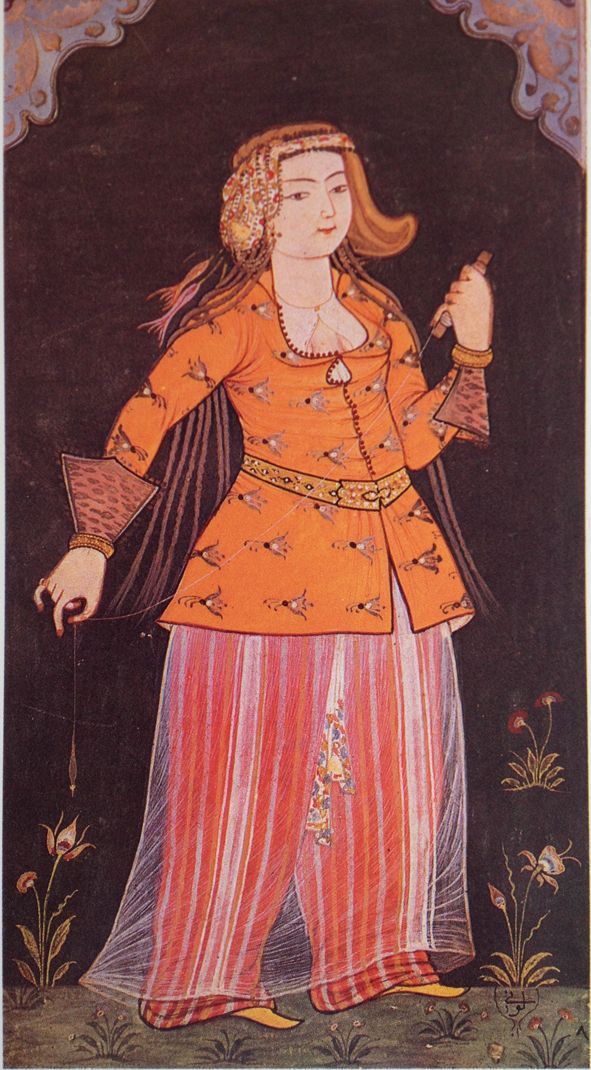

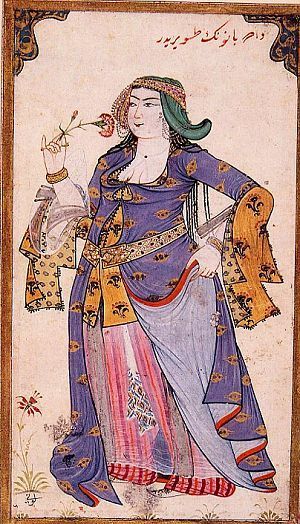
Similar styles of many long braids started a few inches away from the scalp are still used in Turkic groups such as Uzbeks and Uyghurs, particularly while wearing folk dress.
Sources/further reading:
Edward William Lane, The Manners and Customs of the Modern Egyptians.
Heather D. Ward, Egyptian Belly Dance in Transition: The Raqs Sharqi Revolution, 1890-1930
Unfortunately I don't have more to offer you, even for the Turkish style.
110 notes
·
View notes
Text




🌹🗡️
A little doodle of modern day casual fashionable laughter-loving Aphrodite and bodybuilder/gymbro Ares.
Aphrodite still adorned herself with tons of Egyptian and Levantine jewelry, proud of her Middle Eastern roots and her own home in the island of Cyprus, where Asia, Africa and Europe met together. I think that her style of would be something similar to the Levantine and Egyptian Arab Christians would wore today, in the East. Only veiling and modesty practices when coming into a holy place of worship, necessarily.
For Ares, I just styling him with comfortable athletic clothes layering on top of each other, with the usual jewelry collection that he wore. His EOK (Hellenic Basketball Federation) jersey is a tribute to Greek athlete Giannis Antetokounmpo.
#ancient greek#aphrodite#ares#my art#mars#venus#modern day greek mythology#greek mythology#modern fashion
15 notes
·
View notes
Text
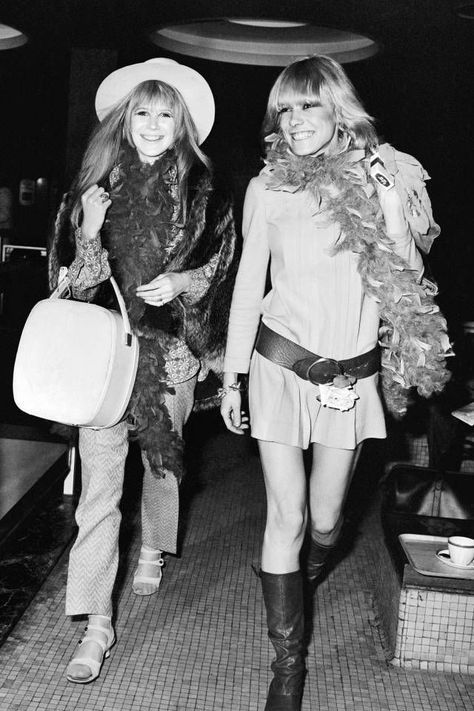


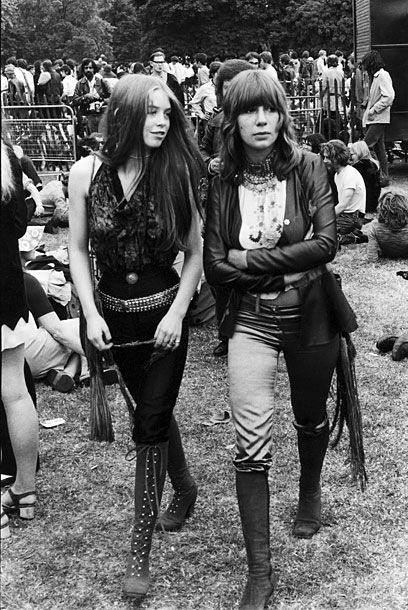
★☆THE ESSENTIAL ROCK N ROLL STYLE GUIDE (PART 1)★☆
Second-hand, thrift and vintage stores are your best friend - especially the aisle that no one can find and the corners that no one is bothered to rummage. First priority is to choose a rock muse style icon. Pattie Boyd’s cut-crease makeup, perfect pout and psychedelic mini skirts, Marianne Faithfull’s thick bangs and love for velvet and snake-skin, Pamela Des Barres’ wild locks and clown makeup, Anita Pallenberg’s chunky belts, hot pants and huge sun hats, Bebe Buell’s 70s cover girl waves and backless halters, Linda Keith’s fur hats, Ginger Gilmour’s golden ringlets and lace bell-bottom sleeve tops, Mary Austin’s skinny scarves and bohemian prints, May Pang’s octagonal sunglasses and straight jet black hair, Linda McCartney’s classy midi skirts, Lori Maddox and Sable Starr’s spandex shorts, wedgie platforms and crazy hair, Charlotte Martin’s baggier effortless Parisian style, Alice Ormsby Gore’s bohemian layering and flowy midi skirts, Jenny Boyd’s medieval-esque dresses and peasant-style, Iggy Rose’s eye crystals and makeup, and of course Miss Priscilla Presley’s perfect feline Egyptian cat-eye, black hair and ivory complexion. Groupie rock muse style ranges from where you’re going to who you’re seeing. If you’re offering your boyfriend arm candy at his Album Launch, you’re not going to be wearing the same pair of hot pants and lace-up boots that you did at his last concert. And if you’re lounging around in the studio at 12am, you’re not going to be wearing that glam paisley dress you wore backstage on tour. Groupie style is all about knowing what to wear and where to wear it. Gigs and concerts will call for a more flamboyant, and ‘out-there’ look. Style staples for concerts and gigs include hot pants, knee-high boots, snake-skin, fur coats and of course afghan coats, chunky jewelry, face gems and body glitter, halter tops and mini skirts and dresses. This is very similar to festival style if your rockstar boyfriend is playing there - however, more flowy and bohemian styles are more welcome and especially face gems and body glitter. Sun hats, lace-up gladiator boots and sandals, and peasant maxi dresses and blouses.
Stay tuned for part 2 where I will be discussing style staples for album launches and recording sessions.
#60s#70s#bebe buell#pattie boyd#the beatles#groupie#rockstar girlfriend#70s fashion#classic rock#priscilla presley#anita pallenberg#pink floyd#the kinks#60s music#rock music#the rolling stones#linda mccartney#cynthia lennon#paul mccartney#george harrison#mary austin#jenny boyd#john lennon#manic pixie dream girl#it girl#christiane f#70s grunge#penny lane#almost famous
86 notes
·
View notes
Text

Sekhmet Brooch by Cartier, Circa 1925
Gold, Platinum, Blue Egyptian Faience, Diamonds, Rubies, Emeralds, Onyx and Enamel
Photo: Cyrus McCrimmon
Source: nytimes.com
#cartier#cartier brooch#egyptian style jewelry#egypt#sekhmet#multi gem brooch#multi gem high jewelry#high jewelry#luxury jewelry#fine jewelry#fine jewellery pieces#gemville
221 notes
·
View notes
Text

I made a fan design for a Freak Du Chic Cleo! See under the read more for more about her design!

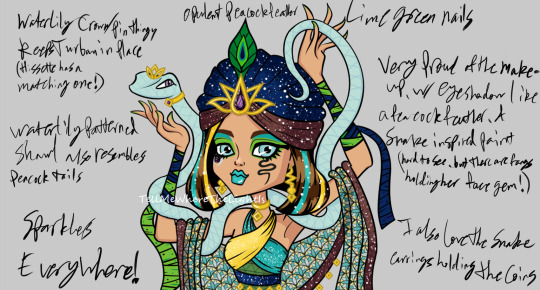
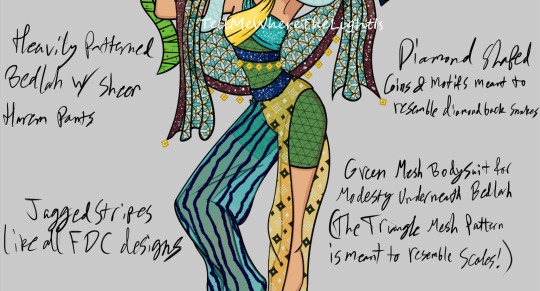
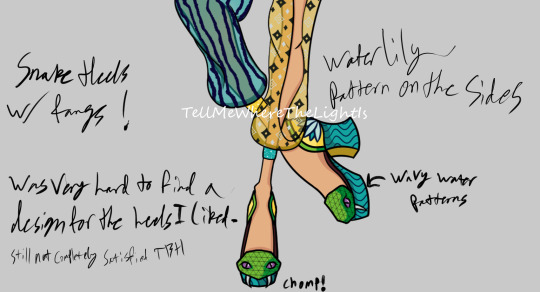
I'm an aspiring designer, and I've always loved Monster High, so I love making my own designs for the characters. I've finally worked up the courage to post some of my art, and first up is my FDC Cleo, based on belly dancing and snake charming.
For her design I went with snake and lotus patterns everywhere, her mesh bodysuit is meant to evoke snake scales while also being a triangular version of FDC’s checkerboard patterns, and she has a peacock feather in her turban bc they were associated with Amon-Ra and the eye of Horus, and lotus were a common motif in ancient Egypt and not something Cleo often has in her designs. Her outfits is based off of bedlah, an outfit often worn by raqs sharqi performers, more commonly known in the west as belly dancers, but modified to be more age appropriate for a character that’s in high school (despite her being thousands of years old, but I wasn't very comfortable with putting her in a super revealing outfit tbh), and also being true to modern Egyptian dancers, since it is illegal for women to publicly bare their midriffs, so the mesh bodysuit underneath was a good fit for her. It was tricky to strike the balance between what people think belly dancers wear and more traditional styles of outfit, but I hope I managed well enough (my mother belly danced frequently in my youth, and her costumes, albeit not Egyptian but Turkish in origin, actually covered her from head to toe. The peacock feather was actually inspired by some of her outfits!). Her sheer harem pants have two different designs going on, the jagged stripes found on many FDC dolls, and a starry diamond pattern that was partially inspired by diamondback rattlesnakes. She has some snake designs on her shoes and hidden in her clothing, and the dangly jewelry and coins all over are both inspired by real life costumes and Cleo’s own triangle and gem designs.
I hope people like her, I'm not the best artist, but I tried to replicate the Monster High style as faithfully as possible, since it's so different from my usual style. Please let me know what you think! <3
PLEASE Tumblr don't compress these images too much I'm BEGGING you
12 notes
·
View notes
Text

elf designs -- click for detail. this is a redraw and i shall not post the original lol. lore under the cut.
so a long time ago when i was ironing out my design for legolas, i ended up doing rough sketches for some clothing variations among cultures of elves encountered in lotr. mostly so i would have an idea of how to make my character designs visually distinct -- i do this a lot. anyway, putting aside for a moment the obvious noldor vs sindar vs nandor divisions, we encounter three main groups of elves in lotr -- the silvan elves of mirkwood/eryn lasgalen, the galadhrim of lothlorien, and elrond's host in rivendell. i wanted designs of what amounted to an "average citizen" of each of these communities -- this is what i came up with!
mirkwood elves were artistically influenced by grecian and egyptian styles. i use circular shapes and emblems for jewelry, and try to give them a more rustic look. Their garments are simpler, employing ties and pins to achieve certain shapes instead of tailoring. due to their ancestry, most have dark hair, though thranduil, the ruler of the realm as of the third age, had golden hair, and tauriel, the elf added in the hobbit movies, has reddish hair. i try to mix it up.
lothlorien elves -- their garb is more ceremonial in appearance, including tailored seams and fine jewelry. i give them light hair, usually. Due to their isolation, i style their garments as more traditionally ‘elvish’, with elements inspired by the natural world: petal and leaf shaped skirts and sleeves.
since the elves of rivendell have more interactions with the outside world and cultures of men than the silvan elves, i gave them a less elvish and more “modern” appearance, featuring elements of design from renaissance fashion, particularly the richness of fabric, the heavy decorative elements, the slashing of sleeves, and the headdresses. Though they retain elvish sensibilities and silhouettes, i made them out to be more in alignment with the traditions of men, to reflect the lord of rivendell’s half-elven heritage and their close political relationship with gondor. i tend to give them dark hair to align them with elrond and arwen.
apologies to actual tolkien nerds. i havent even read the silm LOL
153 notes
·
View notes
Text

Ancient Egyptian 'Mummy Portraits' From Nearly 2 Millennia Ago
These ancient 'mummy portraits' provide a window into ancient Egyptian life and culture.
In the early first millennium, many mummies in Egypt were affixed with lifelike portraits showcasing the deceased's once-vivid eyes, styled hair and elaborate jewelry. Over the past few centuries, archaeologists have unearthed more than 1,000 of these mummy paintings, largely from the city of Fayum, earning them the name "Fayum portraits."
These well-preserved, mesmerizing portraits still captivate, prompting Allard Pierson, a museum in Amsterdam, to feature nearly 40 Fayum portraits in its exhibit "Face to Face: The People Behind Mummy Portraits," which opened Oct. 6 and runs through Feb. 25, 2024.
The portraits, created during Egypt's Roman period (30 B.C. to A.D. 395), often depict individuals with European heritage, who moved to the area following Alexander the Great's rule, the subsequent Ptolemaic dynasty (305 to 30 B.C.) led by one of his generals and the Roman period, when the empire made Egypt into a province.
The portraits were often painted on wooden panels with the two upper corners cut off so they could be easily inserted into the mummy bandages, over the face of the mummified body, Ben van den Bercken, curator of the Collection Ancient Egypt and Sudan at Allard Pierson saiid.
Below are 12 of the portraits, each revealing hints about the deceased and their culture.
Portrait of Ammonius
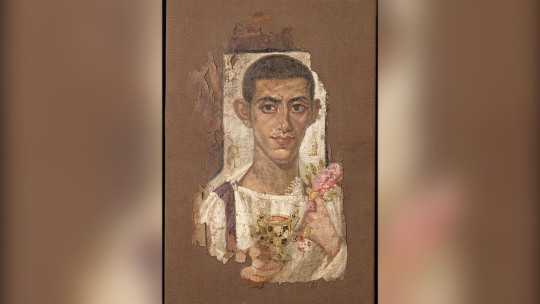
In the restored "Portrait of 'Ammonius,'" painted on linen sometime between A.D. 225 and 250, a young man holds a chalice in one hand and a flower bouquet in the other. The artist gave Ammonius several distinctive features, including large lips, prominent ears, eye bags and strangely curved fingers, according to the book "Mummy Portraits in the J. Paul Getty Museum" (Oxford University Press, 1982).
Pearl earrings

This portrait, painted between A.D. 150 and 200 on wood, shows a young woman with brown doe eyes, a slender nose and thick eyebrows. Pearls, like the ones she wears, are one of the "most ubiquitous" types of earrings in the Fayum portraits, van den Bercken said. Jewelry and hairstyles can help researchers date the portraits, he noted. For instance, women's hairdos could "be very elaborate" and often reflected fashions and trends from Rome itself, "mainly [from] the empress," he said.
However, it's always a question how long it took the fashions of Rome to reach Egypt. In some cases, "something fashionable in Egypt might have already gone out of fashion in Rome itself," van den Bercken said.
Bearded man
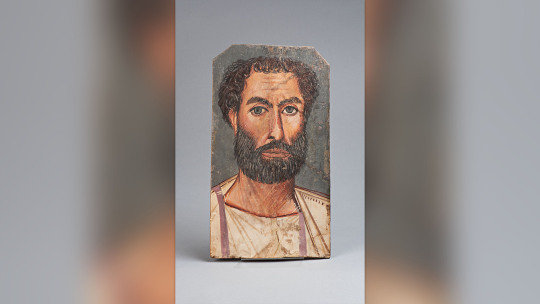
In this portrait, painted on wood sometime between A.D. 175 and 225, we see a curly-haired, bearded man clad in white. The man's beard may mimic the facial hair of Roman emperor Marcus Aurelius (reign 161 to 180), who also sported a beard.
Elegant jewelry

This portrait, painted on wood sometime between A.D. 175 and 200, shows a dark-haired woman wearing a matching necklace and earrings. However, as in other Fayum portraits, it's unclear if it portrays the deceased when they were younger or around the time of death.
In some cases, the portraits were fairly accurate, according to a 2020 study in the journal PLOS One. A team took a CT (computed tomography) scan of a young boy's mummy from Roman Egypt, digitally reconstructed his face and then compared the reconstruction with his portrait. According to an analysis, the portrait made the child look younger than his 3 or 4 years but was otherwise spot-on.
Vivid eyes

This male portrait, painted circa A.D. 250 on limewood, was purchased in the early 1800s by Henry Salt, the British vice-consul in Egypt, making it one of the earliest Fayum portraits recovered in the modern age, according to "Mummy Portraits in the J. Paul Getty Museum."
The earliest record of a Fayum portrait being collected dates to 1615, when a group of the paintings was brought from Saqqara, Egypt, to Europe by the Roman nobleman Pietro della Valle.
Girl with gold wreath

In this portrait, painted on wood between A.D. 120 and 130, we see a young girl wearing a pearl necklace and a golden wreath in her hair. "This wreath is an indication that she 'overcame' death," van den Bercken said.
Man with gold wreath
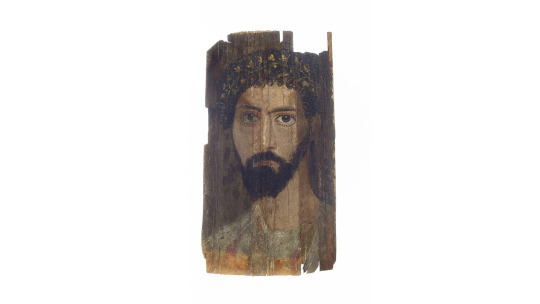
Women weren't the only ones painted with gold wreaths. In this portrait, painted on wood sometime between A.D. 150 and 200, we see a bearded man sporting his own gold laurels.
Realistic portraiture
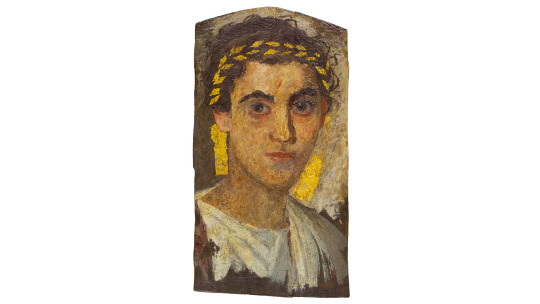
This portrait, painted circa A.D. 150, shows a man clothed in white and wearing a gold wreath. The Fayum portraits' compelling images inspired artists painting icons in the late Byzantine Empire, as well as artists in the late 19th and 20th centuries, according to Allard Pierson. Today, this style is seen as one of the earliest known examples of realistic painted portraiture.
Curly-haired man

This man's beard helped researchers date his portrait to the reign of Emperor Marcus Aurelius. Like others with portraits, the man painted here may have had European roots. Many Greeks and Romans lived in Egypt, first during the Ptolemaic dynasty, which started when one of Alexander the Great's generals took over the region, and later when Rome made Egypt into a province following the death of Cleopatra VII.
Eyes and eyelashes

This portrait, painted on wood between A.D. 300 and 400, shows a woman wearing pearl earrings. "A lot of detail has been put in the composition of eyes and eyelashes," van den Bercken said. A few clues hint that the deceased were upper-middle class or elite, including that many wore ornate jewelry in these portraits. In addition, individuals or their families had to pay an artist for the portrait. "They were not easy to make, not cheap to make resource-wise," van den Bercken said. "The people who ordered them must have had some financial means to do this."
Fancy necklace
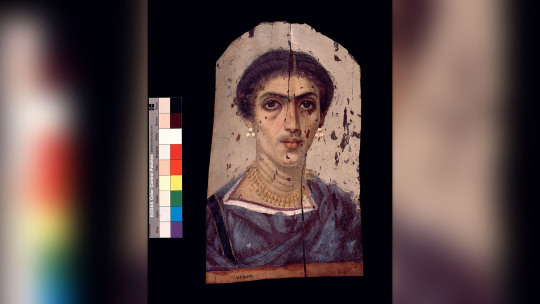
This woman's portrait was painted sometime between A.D. 160 and 190. The majority of known Fayum portraits were found in the 1800s, but in 2022, archaeologists announced that they had discovered more at a cemetery in the ancient city of Philadelphia in Egypt.
Bright-eyed woman

This portrait, painted on wood between A.D. 170 and 200, was found in Egypt in the 1880s, according to "Mummy Portraits in the J. Paul Getty Museum." The woman wears pearl earrings, a necklace, a hot-pink tunic and black clavi, or vertical strips of ornamentation. Her curly hair is drawn into a bun.
By Laura Geggel.
#Ancient Egyptian 'Mummy Portraits' From Nearly 2 Millennia Ago#Fayum Egypt#Fayum portraits#ancient paintings#ancient portraits#ancient artifacts#archeology#archeolgst#art#artist#art work#art world#art news#history#history news#ancient history#ancient culture#ancient civilizations#roman history#roman empire#ancient agypt#egyptian history#egyptian art#roman art
30 notes
·
View notes
Text
My Gift to You

Luna gives Spencer a special bracelet.
Pairing: Spencer Reid x OFC
Word Count: 664
Warnings: none really. mentions of sensory issues but nothing major
A/N: i was rewatching jus in bello and got an idea after dean gave everyone anti-possession necklaces. she's just a wee little drabble but i wrote this in 18 minutes and im not super proud of it but tbh im a little proud bc i havent written in so long don't ask me if they have feelings for each other here bc they definitely do but theyre still newly friends and we all know babygorl spencer isn't the type to rush into relationships especially with a student in a class he TAs for
Masterlist
Ninety-one days, thirteen hours, and twenty-seven minutes after their first meeting, she gave him a bracelet.
Normally, Spencer didn’t love jewelry— necklaces moved around too much throughout the day, most bracelet materials made him uncomfortable, and rings collect five hundred and four colonies of bacteria on average. He even avoids the feeling of bare wrist against his watch (over two thousand bacterial colonies) by placing the offending item over his long-sleeve whenever he can. But as he stared at the band presented before him with little symbols etched on beads and Luna’s doe eyes, he knew that he would wear this bracelet every day of his life, sensory issues be damned.
He gently took the accessory from her hands, his eyebrows furrowing as he felt the fabric threading each bead and its soft texture. Upon a closer look, he realized it was braided cotton intricately woven in a tight pattern— nothing like he had ever seen before.
“I, uh…I figured the cotton would be easier on your skin and wouldn’t bother you as much,” Luna finally said, breaking the thickening silence that was gradually building in his office. “The pattern is supposed to be a ‘spell of protection’…if you believe that kind of stuff…same with the symbols…” she trailed off with uncertainty when he didn’t acknowledge her comment.
He stared at the complicated pattern, knowing it must’ve taken her hours to braid with such precision. Each knot was exactly the same as the one before it and the one after. There were neither frayed ends nor rough seams. Even the beads were perfectly spaced apart— 1.2 inches, if he were to guess. Each bead had a different symbol that was carefully etched on by hand. One looked vaguely like a pentagram inside of a sun— a symbol that Luna had on one of her necklaces he had seen before— and another pentagram with strange runes in between each point. Another one seemed to have characters similar to those of the ancient Germanic alphabet. He wasn’t sure what these symbols meant and why she was giving this to him, but he was in awe of the time and effort that went into the unique gift.
“Spencer, if you don’t like it, y—”
“Like it?” He cut in, his voice soft and delicate. “Like it? Luna, I love it.”
He cleared his throat and when he spoke this time, his voice was stronger and more confident as he rattled off the knowledge that he did know.
“Actually, did you know that from 3500 BCE to 3100 BCE, the ancient Egyptians were known for their intricate braids? Upper-class men and women would wear elaborate braided styles bedazzled with beads, jewels and gold thread. It was already tightly ingrained in their culture even before Cleopatra’s revolutionary braided styles. It was believed that braiding hair would bring good luck and—”
“Ward off evil spirits,” Luna finished for him.
“Yeah.” Spencer smiled softly. “This is incredible. I’ve never gotten a gift like this before. Thank you.”
Infinite starlight could never come close to Luna’s beaming smile, and his heart skipped a beat at her poorly stifled giggles as he attempted to put on the bracelet by himself. One look at his puppy eyes and Luna caved, mirth shining in her eyes as she offered her assistance.
“What do the symbols mean?” His innate curiosity and desire to acquire new knowledge never ceased to arise when the situation presented itself.
“I’ll tell you some day,” she replied simply. “Promise me you’ll always wear it? It’ll keep away the demons.”
Her tone was light and seemingly airy, but Spencer’s perceptive nature picked up on the worry and desperation that flashed in her eyes. As she finished fastening on the accessory, she fiddled with it as she waited for his response.
“I’ll never take it off,” he promised, his words laden with truth. She had given him a special piece of her. Who was he to ever deny it?
#criminatural#criminal minds#supernatural#criminal minds x supernatural#spencer reid x ofc#spencer reid x younger sister!winchester#spencer reid#younger sister!winchester#fluff#criminatural drabble#muffinbeliever
16 notes
·
View notes
Text

Been doing research into Phoenician deities recently, and obviously I started with Ashtart just with how prevalent she is across the Mediterranean. This was to hold me over before I had finalized her actual design, which pulls more from Egyptian artwork of her just to put more emphasis on the war god aspect of her. In Levantine and Cypriot artwork I always found the nature of this pose very fascinating.
some more explanation under the cut!
Scars- I have a habit of giving war deities scars in my art. I like scars and think they’re pretty. They’re meant to look kind of golden.
horns- honestly more of a stylistic choice than anything? It’s kind of a pun on the Astarte horn in Antarctica and Ashteroth Karnaim but also referencing Ishtar’s horned crown and her connections to Astaroth in later demonology.
jewelry- the earrings are simple hoops that are directly referenced from some extant artworks. The gold armbands and faience bracelets are kind of just for fun but also because I felt it could be plausible. The choker is also faience, but it’s directly referenced from a sculpture from Cyprus identified as Ashtart on an Astarte throne. For her fillet I also referenced that sculpture’s eight pointed star and some gems like garnets, pearls, and lapis inset. There’s also a golden crescent and star which is more so for adding more to the space and kinda a nod to a lot of the old interpretations and idea of her being the evening star even though there’s no evidence for that. It’s pervasive so I kind of just wanted to give it a bit of a nod.
hairstyle- Ashtart tends to be depicted with Egyptian style hair/wigs. I went for a hathor wig here since it’s the hairstyle she has on the bronze carriazo found in Seville, as well as easier for me to draw and connected with Qetesh, an Egyptian goddess with syrio-palestinian motifs who is commonly syncretic with her and Anat.
pose- Astarte figures are depictions of women in sculpture clutching their breasts. The actual connection to Ashtart is kinda… situational? But they are a pervasive part of her iconography and some are definitively associated with her. In hindsight this is also totally a pinup…
Sphinxes/cherubim- these are defining aspects of Astarte thrones, so I thought it would be interesting to incorporate, even if she’s not sitting here.
Halo and border patterns- these are just replicating some of the decorative elements in Syrian ivory reliefs from the era. I find them very beautiful.
#Artwork#nudity#Astarte#Ashtart#phoenician mythology#mythology#traditional art#art#alcohol markers#Canaanite mythology#Pinup#Pinup art#Lmao the pinup was unintentional#I just like having love/beauty/sexuality goddesses being sexually confident in themselves lol
6 notes
·
View notes
Text
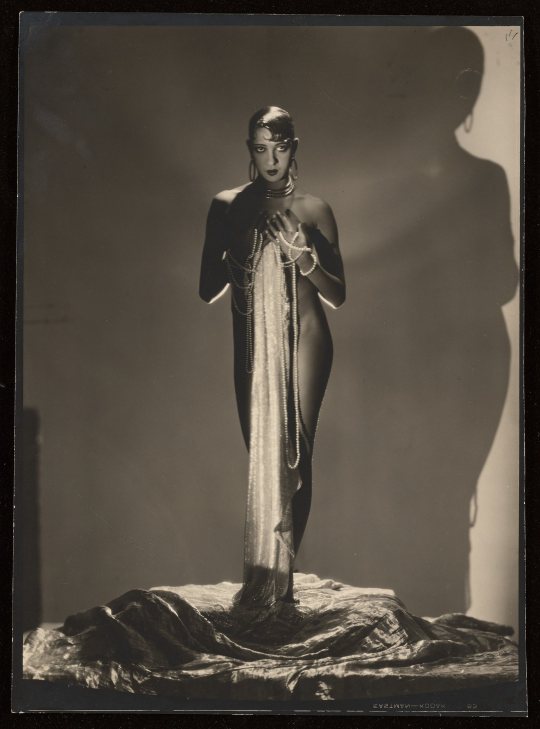
George Hoyningen-Huene, Josephine Baker, for Vanity Fair, 1929
In one of the most iconic images of her long iconic career, Josephine Baker posed for Vanity Fair wearing necklaces designed by Art Deco period French designer Jean Dunand (and not much else).

Jean Dunand, "Giraffe" jewelry set, ca. 1927, oréum and lacquer
Dunand's jewelry designs show the influence traditional African arts and crafts had within the Art Deco period, as their strong geometric motifs became increasingly referenced in Western art. Also influencing Dunand's design is the popularity of Egyptian revival styles in jewelry which began after the discovery of the Tomb of Tutankhamun in 1922.
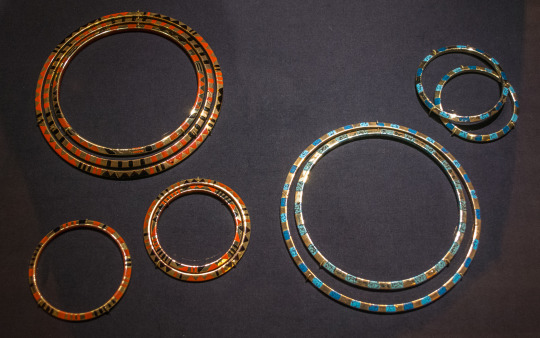
Dunand's "Giraffe" jewelry was immensely popular within its time, worn by celebs and socialites, and produced in two color variants.
12 notes
·
View notes